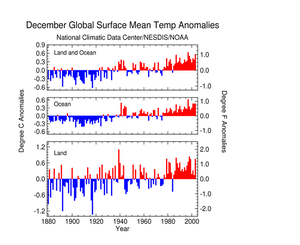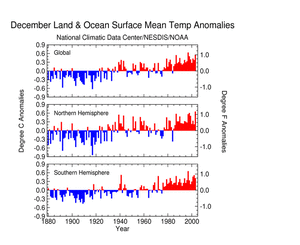Global Highlights:
- Based on preliminary data for December 2003, global average
combined land and sea surface temperature was second warmest on
record
- Temperatures were much above average across most of the U.S.,
Canada and Europe with below average temperatures across Argentina,
the southeastern U.S., and the northern territories of
Australia
- Precipitation during December 2003 was above average across
Scandinavia and the northeastern U.S., with drier than average
conditions across Ireland, and southern India
- Slightly warmer than normal SST's remained across the
equatorial Pacific basin but do not indicate that the warm episode
will transition into an El Niño event.
|
|
Contents of this Section:
|
The data
presented in this report are preliminary. Ranks and anomalies may
change as more complete data are received and processed. The most
current data may be accessed via the Global Surface
Temperature Anomalies page.
Introduction

larger
image
|
December temperature
anomalies calculated from the Global Historical Climatology Network
data set of land surface stations (using a 1961-1990 base period)
also show above average temperatures across the majority of the
U.S. and Canada, Russia, Brazil and the southern of Australia.
Monthly temperatures were 2-5°C (3.6-9°F) above the mean in
many of these areas. Cooler than average temperatures were present
in Chile, the Aleutian Islands, southeastern U.S. and South Africa
where monthly temperatures were as much as 2-4°C
(3.6-7.2°F) below average. |
Temperature
December
- For December 2003, the global average land and
ocean surface temperature was 0.55°C (1.00°F) above the
1880-2002 average, ranking as the second warmest December in the
period of record
- Globally averaged land
temperatures were fifth warmest on record, 0.74°C (1.33°F)
above the long-term mean
- Globally averaged ocean surface
temperatures were 0.46°C (0.83°F) above the 1880-2002 mean,
third warmest on record for December 2003.
|

larger
image
|
- December 2003 temperatures averaged across the
Northern Hemisphere were warmest on record, 0.65°C (1.17°F)
above the long term mean
- Temperatures averaged throughout the Southern
Hemisphere were seventh warmest, 0.41°C (0.74°F) above
average
|

larger
image
|
January-December
- For January-December 2003, the global average
land
and ocean surface temperature was 0.57°C (1.03°F) above
the long term mean, second warmest
- Globally averaged land
temperatures were third warmest on record, 0.85°C (1.53°F)
above the long-term mean
- Globally averaged ocean
surface temperatures were 0.44°C (0.80°F) above the
1880-2002 mean, second warmest for January-December 2003.
- January-December 2003 temperatures averaged
across the Northern Hemisphere were second warmest on record,
0.65°C (1.20°F) above the long term mean
- Temperatures averaged throughout the Southern
Hemisphere were third warmest, 0.46°C (0.83°F) above
average
|

larger
image
|
- For a complete historical review of Global
conditions during 2003, please see the Annual report.

larger
image
|
- Serial monthly global surface temperature
departures with respect to a 1971-2000 mean are shown in the figure
to the left
- Globally averaged surface temperatures (land and
ocean) have been warmer than the 1971-2000 average for the last 92
consecutive months
|
Precipitation
- During December 2003, much above average
precipitation fell across Indonesia, the western and northeastern
U.S., Bolivia and Norway
- Below average precipitation was observed in
southeastern Asia, the Mississippi Valley of the U.S., Pakistan and
the United Kingdom
- Additional regional analysis can be found on the
Global Hazards page
|
 larger
image
larger
image
|
ENSO SST Analysis
References:
Peterson, T.C. and R.S. Vose, 1997: An Overview of the Global
Historical Climatology Network Database. Bull. Amer. Meteorol.
Soc., 78, 2837-2849.








 NOAA's National Centers for Environmental Information
NOAA's National Centers for Environmental Information

